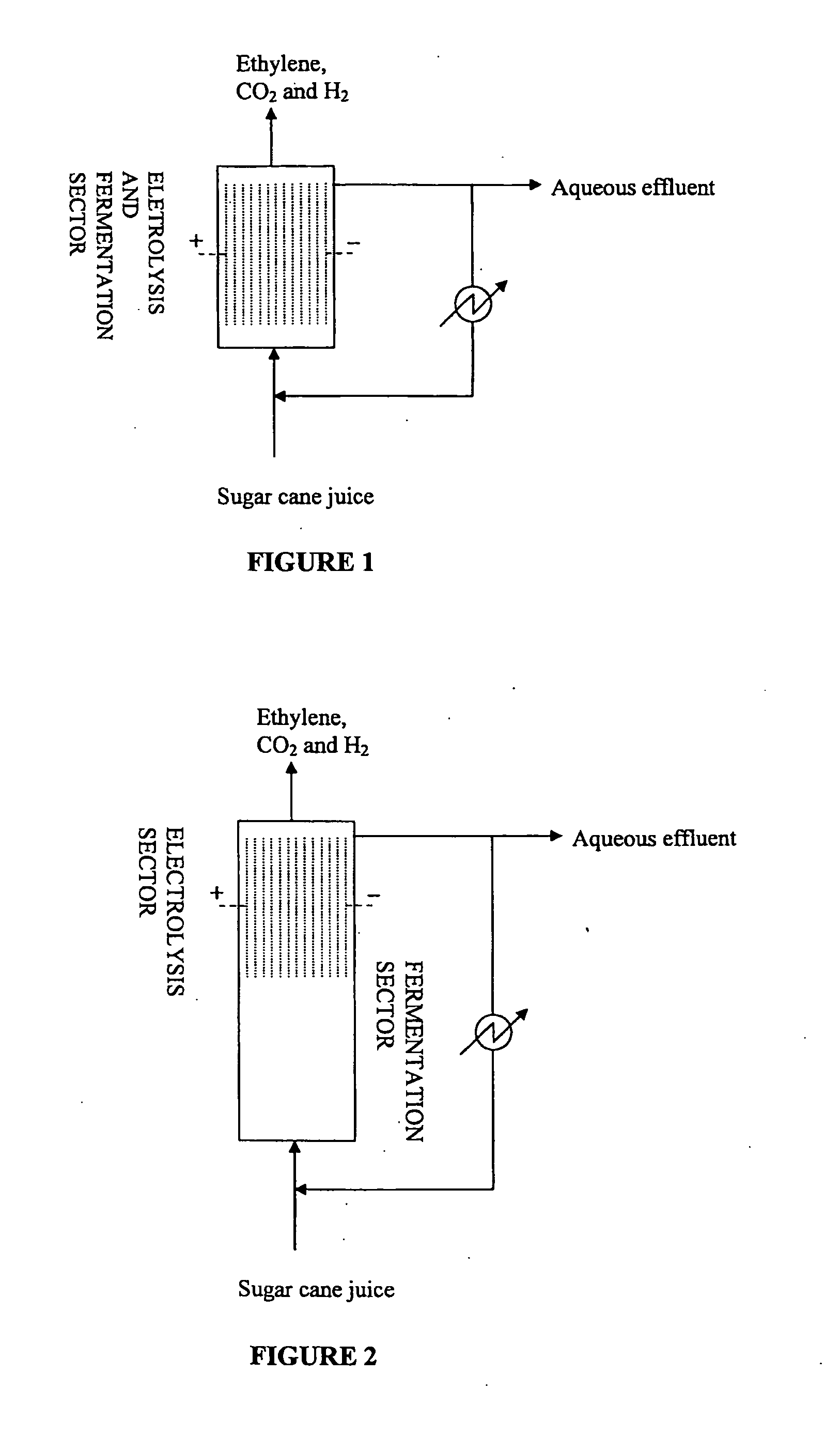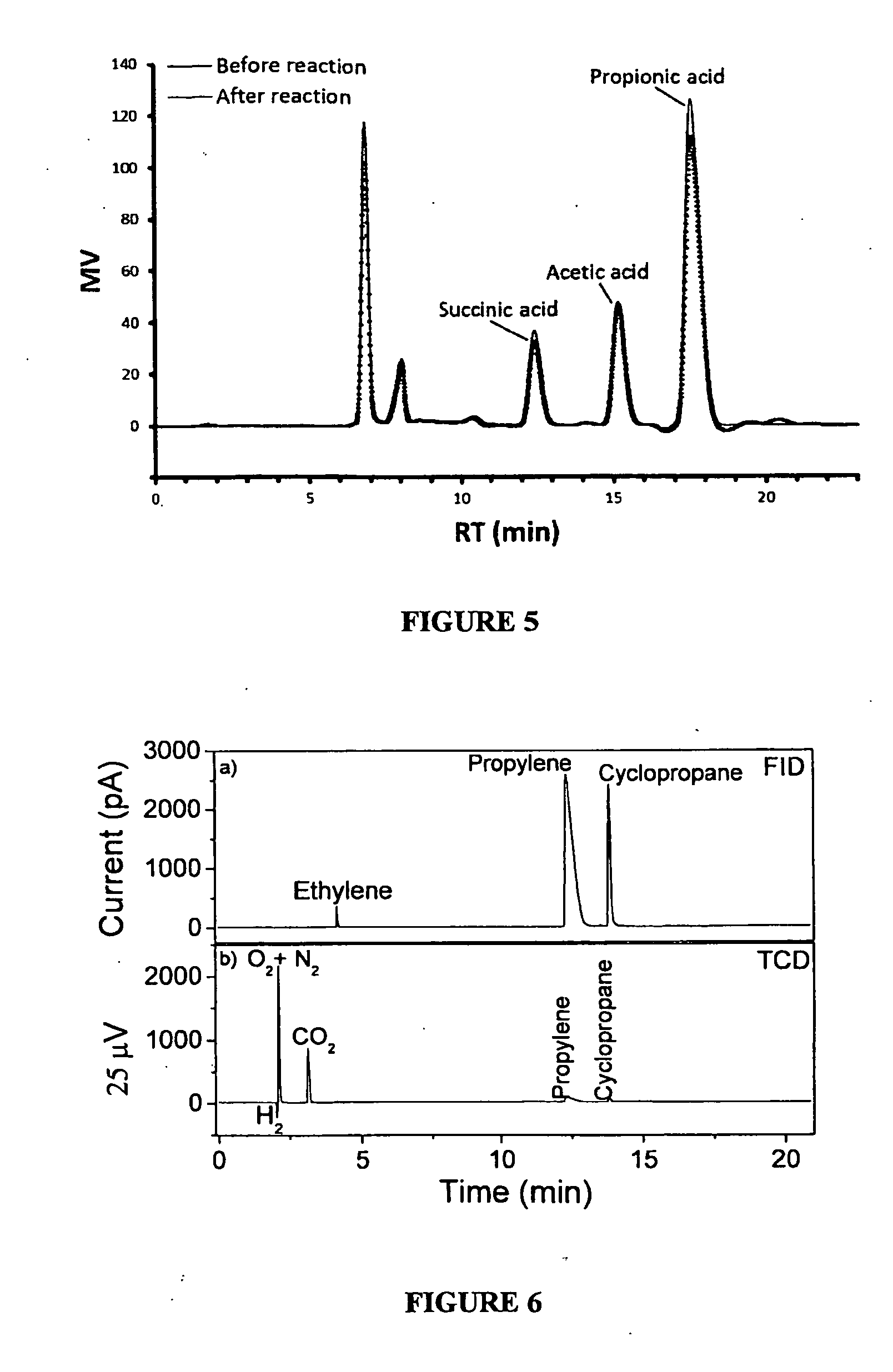Method for the production of olefins, an olefin, a polyolefin, and use of the polyolefin
a technology of olefins and polyolefins, applied in the direction of electrolytic organic production, hydrocarbon oil treatment products, sustainable manufacturing/processing, etc., can solve the problems of not being commercially exploited, and not very competitive on the rou
- Summary
- Abstract
- Description
- Claims
- Application Information
AI Technical Summary
Benefits of technology
Problems solved by technology
Method used
Image
Examples
example 1
[0109]Fermentation of Sugarcane Juice by Propionibacterium acidipropionici and Ethylene Production and Extraction by Anodic Electro-Decarboxylation Reaction
[0110]A wild strain of Propionibacterium acidipropionici (ATCC No. 4875) was used to study propionic acid production using sugarcane juice as a carbon source. The bacterium was cultured in a medium containing sugar cane juice diluted in water and supplemented with 1 g / L of yeast extract. At dilution, the starting concentrations of sugars in the diluted sugarcane juice medium were measured at 38.5 g / L of sucrose, 9.9 g / L of glucose and 6. g / L of fructose. The medium was sterilized at 121° C. and 1 kgf / cm2 for 20 min prior to use.
[0111]Free-cell batch fermentation was conducted in a 2.5 L bioreactor (Labfors—Infors HT) containing 1.0 L of the sterile medium inoculated with 100 ml. of pre-adapted cells of P. acidipropionici. The bioreactor temperature was maintained at 30 deg. C. and the agitation speed at 100 rpm. In th...
example 2
Propylene Production and Extraction by Anodic Electro-Decarboxylation Reaction of Butyric Acid
[0116]A solution of 250 mL containing 10.5 g / L of butyric acid and with pH adjusted to 5 with the addition of 10 M KOH was subjected to the anodic electro-decarboxylation reaction. The electrochemical cell consists of a cylindrical glass vessel containing two parallel electrodes, placed 4 mm apart. The anode was a graphite bar (21.6 cm2) and the cathode was a stainless steel bar. Electrolysis was conducted at 300 rpm for 6 hours at a current density of 10 mA / cm2 and 25 deg. C., using an Autolab PGSTAT 302N potentiostat. Prior to the electrolysis, the solution was purged with nitrogen gas for 15 min in order to obtain an inert atmosphere.
[0117]Gas chromatography analyses were performed on an Agilent 7890A apparatus equipped with a split / splitless injector, FID and TCD detectors. Injector and detectors temperatures were 150 and 300 deg. C., respectively. The capillary column was an Agilent 19...
example 3
[0119]Fermentation of Sugarcane Juice by Clostridium butyricum and Prophylene Production and Extraction by Anodic Electro-Decarboxylation Reaction
Fermentation
[0120]A wild strain of Clostridium butyricum (DSM No. 10702) was used to study butyric acid production using sugarcane juice as a carbon source. The bacterium was cultured in a medium containing sugar cane juice diluted in water and supplemented with 0.5 g / L yeast extract, 0.5 g / L peptone, 1.0 g / L trypticase, 0.5 g / L KCl and 500 mg / L cysteine hydrochloride. At this dilution, the starting concentrations of sugars in diluted sugarcane juice medium were measured at 24.9 g / L of sucrose, 3.6 g / L of glucose and 1.9 g / L of fructose. The medium was sterilized at 121deg. C. and 1 kgf / cm2 for 20 min prior to use.
[0121]Free-cell batch fermentation was conducted in a 2.5 L bioreactor (Labfors—Infors HT) containing 1.0 L of the sterile medium inoculated 100 ml of adapted cells of C. butyricum. The bioreactor temperature was maintained at 37...
PUM
| Property | Measurement | Unit |
|---|---|---|
| Concentration | aaaaa | aaaaa |
| Concentration | aaaaa | aaaaa |
| Concentration | aaaaa | aaaaa |
Abstract
Description
Claims
Application Information
 Login to View More
Login to View More - R&D
- Intellectual Property
- Life Sciences
- Materials
- Tech Scout
- Unparalleled Data Quality
- Higher Quality Content
- 60% Fewer Hallucinations
Browse by: Latest US Patents, China's latest patents, Technical Efficacy Thesaurus, Application Domain, Technology Topic, Popular Technical Reports.
© 2025 PatSnap. All rights reserved.Legal|Privacy policy|Modern Slavery Act Transparency Statement|Sitemap|About US| Contact US: help@patsnap.com



